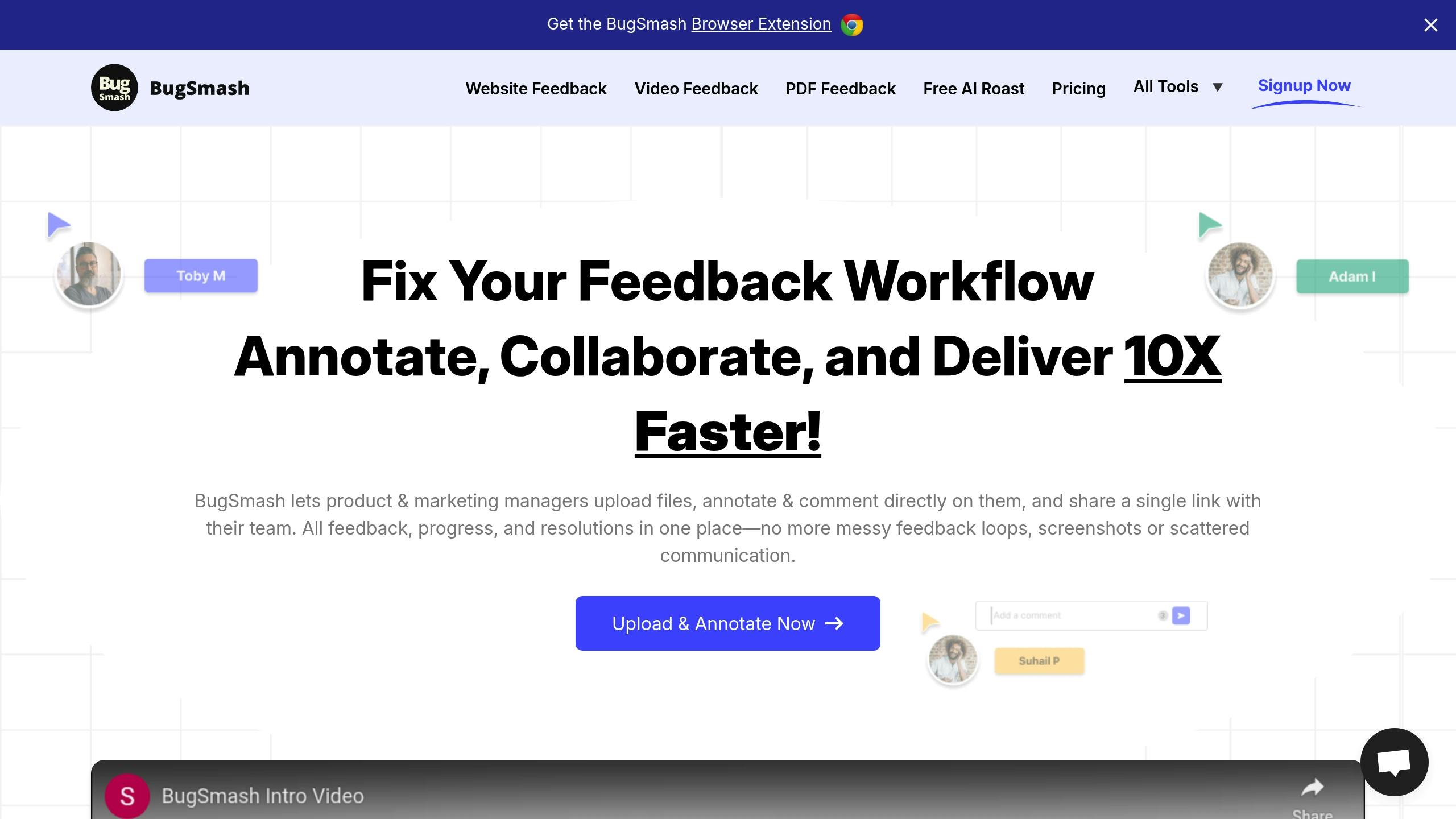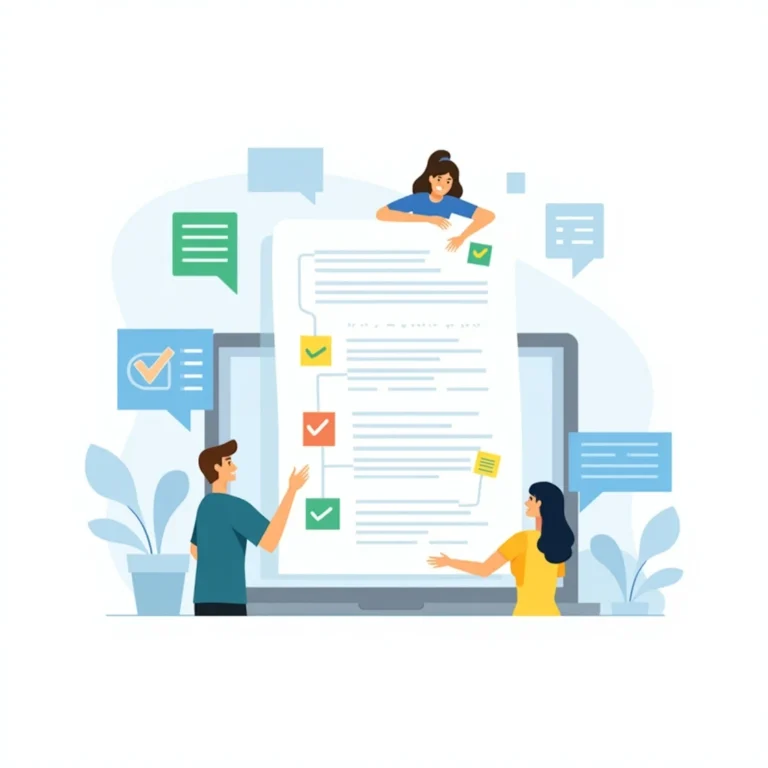Managing feedback effectively can save teams time and improve results. Manual methods like email chains and spreadsheets often lead to scattered, time-consuming processes. In contrast, tools like BugSmash automate feedback collection, organization, and tracking, cutting time spent on these tasks by up to 60%. Teams using BugSmash report faster issue resolution, fewer errors, and better collaboration.
Key Takeaways:
- Manual Feedback Tracking: Relies on tools like spreadsheets and emails but is prone to errors, duplication, and inefficiencies.
- BugSmash: Automates feedback processes, supports multiple file types, and centralizes communication, saving teams time and effort.
Quick Comparison:
| Feature | Manual Tracking | BugSmash |
|---|---|---|
| Feedback Collection | Emails, screenshots | Direct annotations, uploads |
| Organization | Manual sorting | Automated categorization |
| Progress Tracking | Manual updates | Real-time updates |
| Duplicate Feedback | Hard to track | Automatically flagged |
| File Type Support | Limited | Websites, videos, PDFs, etc. |
| Time Efficiency | Time-intensive | Saves up to 60% time |
If your team handles complex projects, remote work, or large volumes of feedback, BugSmash can streamline your workflows and deliver better results.
Visual Feedback Tool – Which Is The Best Tool for Bug Tracking
Key Differences Between BugSmash and Manual Tracking

Switching from manual feedback tracking to automated solutions has become essential for teams, especially with the rise of remote work. A 2020 study by LinearB involving 50 development teams found that manual tracking methods caused a 7% increase in time spent on bug fixes, along with a 7% drop in new feature development . This comparison underscores how automation transforms feedback tracking.
Automated vs. Manual Processes
BugSmash replaces the repetitive tasks of manual tracking with automation. While manual tracking requires constant effort, BugSmash simplifies these key processes:
| Process | Manual Methods | BugSmash |
|---|---|---|
| Feedback Collection | Screenshot capturing, email threads | Single-link sharing, direct file upload |
| Organization | Manual sorting in spreadsheets | Automatic categorization by project/type |
| Progress Tracking | Manual status updates | Real-time completion updates |
| Notification System | Manual follow-ups | Automated alerts and reminders |
Manual feedback analysis takes about 5 hours per 100 responses, while automated systems like BugSmash can handle thousands in just minutes . Additionally, BugSmash’s single dashboard simplifies workflows by consolidating everything in one place.
Single Dashboard vs. Multiple Tools
Teams relying on manual methods often spend nearly half their time – 47% – dealing with bugs and hotfixes , largely because feedback is scattered across various platforms. BugSmash’s unified dashboard addresses this issue by offering:
- Centralized feedback access to reduce context switching
- Standardized workflows, eliminating inconsistent individual processes
- Full project visibility without needing manual reports
- Easy sharing and viewing of feedback across departments
File Type Support
Handling multiple file types on a single platform removes the need for multiple tools, boosting efficiency. BugSmash stands out compared to manual methods:
| File Type | Manual Method Limitations | BugSmash Capabilities |
|---|---|---|
| Websites | Screen captures, written descriptions | Direct page annotation |
| Mobile Apps | Device screenshots, email descriptions | In-app feedback capture |
| Videos | Timestamp lists, separate comments | Direct video timestamping |
| PDFs | Multiple annotation tools | Built-in markup features |
| Images | External editing software | Integrated annotation tools |
| Audio Files | Time-coded notes | Direct audio feedback |
Feedback Quality and Context
Automated systems have been shown to cut feedback errors by 37% . This improvement plays a big role in making feedback management more precise and reliable.
Error Prevention
BugSmash makes feedback clearer with its visual annotation tools, allowing users to add notes directly on the content. Shopify‘s research revealed that switching to automated systems led to a noticeable boost in bug resolution rates . This approach ensures feedback is not only accurate but also actionable – one of BugSmash’s standout features.
| Error Prevention Feature | Manual Methods | BugSmash |
|---|---|---|
| Context Preservation | Requires written descriptions and separate screenshots | Direct visual annotations on the content |
| Feedback Validation | No built-in validation tools | Automated checks to ensure completeness |
| Version Control | Relies on manual tracking | Automatically maintains version history |
Avoiding Double Feedback
Duplicate feedback can derail workflows, causing confusion and wasting time. BugSmash tackles this with a centralized system that detects and flags duplicate entries, cutting redundancy by 75% . When paired with project management tools, teams have reported up to 60% faster response times to critical feedback . By eliminating duplicates, teams can focus on tracking and addressing the most pressing issues.
Progress Monitoring
Tracking progress in real time is another area where BugSmash outshines manual methods. Its automated system provides instant updates on feedback status, leading to:
- A 30% boost in project completion times .
- Better project oversight, with 78% of teams noting improved visibility compared to manual tracking .
- A 40% drop in recurring issues across different projects .
These tools make it easier for teams to stay on top of their work and avoid common bottlenecks.
sbb-itb-54a62c3
Speed and Workflow Impact
Switching from manual feedback tracking to automated systems can transform team productivity and streamline workflows. Data highlights how this shift saves time and simplifies processes, leading to faster project completion.
Time Reduction
Traditional feedback methods often waste up to 10 hours per week on scattered communications. BugSmash automates these processes, cutting down on wasted time significantly. Here’s how it compares:
| Activity | Manual Methods | BugSmash | Time Saved |
|---|---|---|---|
| Screenshot Capture & Annotation | 15 min/item | 3 min/item | 80% |
| Feedback Search & Retrieval | 2 hrs/week | 20 min/week | 83% |
| Response Time to Feedback | 24 hours avg. | 12 hours avg. | 50% |
| Status Update Meetings | 5 hrs/week | 1.5 hrs/week | 70% |
Automated feedback tools like BugSmash process feedback up to 60% faster than manual methods . Features such as automated notifications and centralized feedback collection drive these efficiencies, while also improving communication within teams.
Team Communication
Centralized feedback management improves how teams work together. Research shows that using platforms like BugSmash can increase team productivity by 25% . Additionally, 78% of teams report better visibility and collaboration across departments . By reducing the need for lengthy status meetings (up to 70% less time spent), teams can focus more on decision-making and integrating feedback effectively.
Process Integration
BugSmash helps teams avoid workflow disruptions with its flexible integration options. Supporting multiple file types reduces the need for constant context switching by 40% . Key features include:
- Integration with tools like Jira and Trello, cutting integration time by 80% .
- Customizable workflows that align with existing systems for quicker onboarding.
- Automated version tracking, which lowers error rates by 30% .
Efficiency improvements depend on team size and project complexity. Medium-sized teams (11–50 members) often see gains of 30–50%, while larger organizations managing multi-stakeholder projects can achieve up to 70% improvement .
Use Cases and Constraints
Choosing the right feedback method depends on factors like project complexity, team size, and regulatory requirements. Below, we break down when manual methods work best and when BugSmash becomes essential.
When to Use Manual Methods
For smaller projects or specific scenarios, manual tracking can keep things simple and effective:
| Scenario | Why It Works | Suggested Approach |
|---|---|---|
| Small Projects (<50 feedback items/month) | Minimal complexity and overhead | Use spreadsheets with organized categories |
| Handling Sensitive Data | Full control over data is needed | Maintain strict documentation protocols |
| Limited Internet Access | Offline solutions are necessary | Create a clear paper-based tracking system |
| Industry-Specific Regulations | Compliance with strict documentation rules | Use approved templates and formats |
When to Use BugSmash
BugSmash shines in more complex situations where coordination and efficiency are critical:
| Use Case | Time Saved | Key Advantage |
|---|---|---|
| Cross-functional Projects | Up to 60% faster feedback processing | Centralized communication for all teams |
| Remote Teams | Streamlined communication | Real-time collaboration tools |
| Multi-platform Development | Optimized workflows across platforms | Supports various file types seamlessly |
| Client-facing Projects | Easier client feedback management | Intuitive interface for client input |
System Limitations
Each method has its drawbacks, which should be considered before making a choice:
-
Manual Methods:
- Hard to scale as teams grow
- Risk of inconsistent documentation
- Lacks visual context for feedback
- Becomes time-consuming with larger projects
-
BugSmash:
- Requires steady internet access
- Initial training takes 2-3 hours
- Needs compatible devices and browsers
- Subscription limits storage capacity
In industries with strict regulations, manual tracking may still be required despite its inefficiencies. Studies show teams relying on manual methods spend nearly 47% of their time managing bugs . On the other hand, BugSmash drastically cuts feedback processing time, making it a valuable tool for larger or more dynamic projects .
Conclusion: Making Your Choice
Deciding between BugSmash and manual tracking depends on your project’s specific needs and constraints.
Key Factors to Consider
The choice between BugSmash and manual tracking often comes down to your project’s size, available resources, and how your team operates. Research indicates that automated systems like BugSmash can save up to 70% of the time spent managing feedback .
| Factor | BugSmash | Manual Tracking |
|---|---|---|
| Time Efficiency | Cuts feedback consolidation time by 80% | May take up to 47% of team time |
| Communication | Reduces communication time by 40% | Requires multiple channels and tools |
| Productivity | Boosts efficiency by 25% through less context switching | Slowed by manual data entry and organization |
| Issue Resolution | Resolves issues 50% faster | Relies on human processing speed |
Use this comparison to weigh the pros and cons for your team.
Decision Guide
-
Project Scale and Complexity
- Opt for BugSmash if you’re handling large, multi-stakeholder projects.
- Stick to manual tracking for smaller or offline projects.
-
Resource Availability
- BugSmash is ideal if your budget allows for automation and you want to save time .
- Manual tracking suits teams with limited budgets or strict regulatory requirements.
-
Team Setup
- Remote teams benefit from BugSmash’s streamlined implementation .
- Manual tracking works well for small, co-located teams with straightforward feedback processes.
Some teams find success by blending both approaches. For example, you could use BugSmash for general feedback while reserving manual tracking for unique, tailored events . This hybrid method allows you to take advantage of automation while maintaining flexibility for specialized needs.
FAQs
Here’s a quick look at frequently asked questions about automation versus manual feedback tracking.
Which Feedback Tracking Method Is Better: Automation or Manual?
The best choice depends on your goals and the type of feedback you’re managing. Here’s a comparison to help:
| Aspect | Automated (BugSmash) | Manual Tracking |
|---|---|---|
| Speed | Handles up to 1,000 feedback items per hour | Processes 10–50 feedback items daily |
| Time Efficiency | Cuts feedback time by 60–80% | Requires 70% of the effort spent on feedback |
| Best Use Cases | Ideal for regression tracking, load monitoring, and repetitive tasks | Suited for usability evaluation, exploratory feedback, and user experience reviews |
| Cost Structure | Higher upfront investment, lower long-term expenses | Lower initial cost, but higher ongoing costs |
Many teams find a hybrid approach works best – using automation for repetitive tasks while relying on manual feedback for more detailed, exploratory assessments.
"A cybersecurity assessment indicated that automated systems like BugSmash offer up to 30% greater security than manual tracking via shared documents or emails"
When deciding, think about your project’s timeline, the complexity of feedback, and the return on investment over time. While automation saves time and scales well, manual methods are still essential for uncovering less obvious issues and gaining deeper insights.




